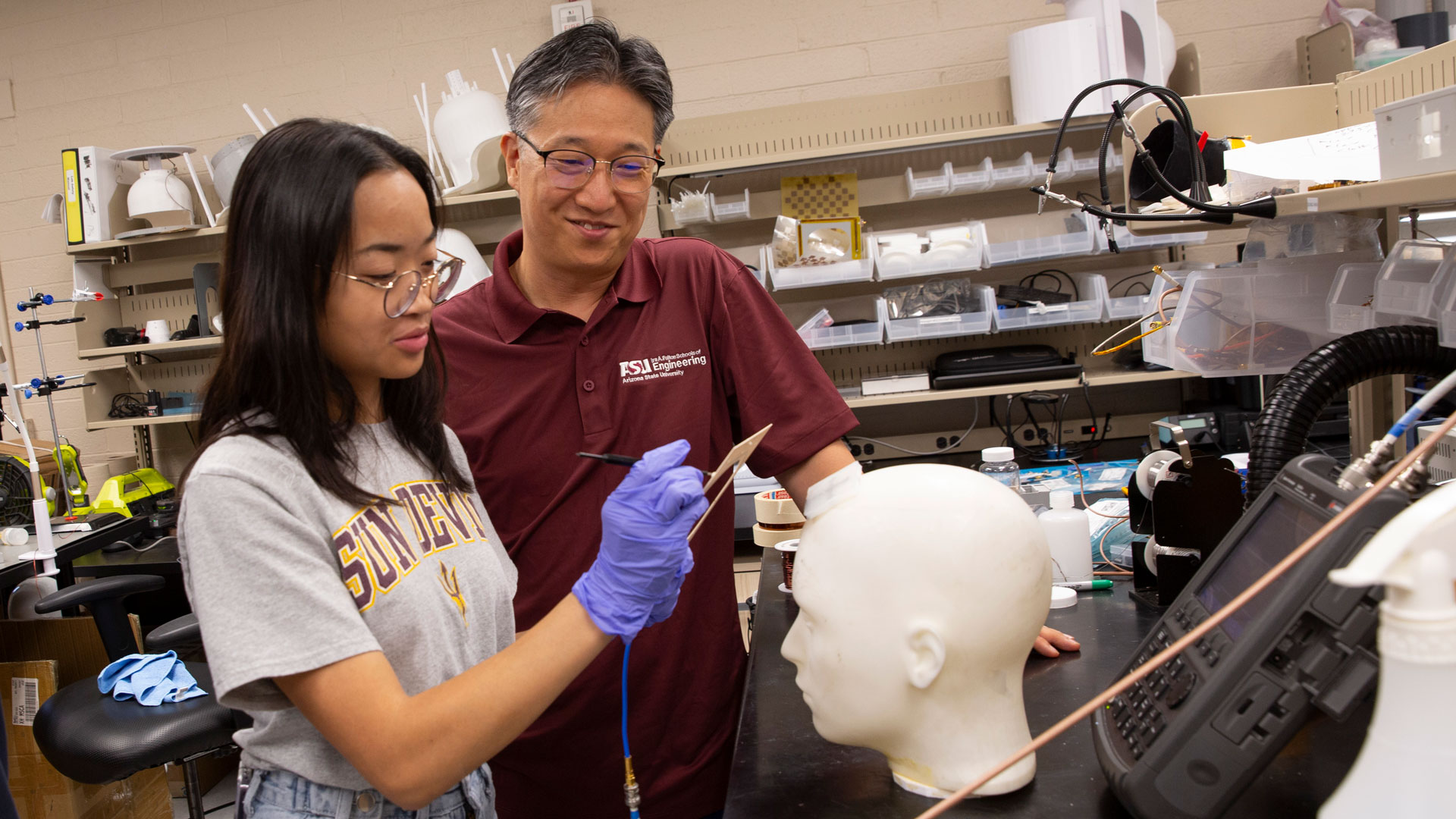
Meet student researchers solving education, health, security and sustainability challenges

This article is the second in a two-part series highlighting student researchers and faculty mentors presenting at the Fall 2023 Fulton Forge Student Research Expo on Friday, Nov. 17. Read part one. Learn more about the expo.
Visualizing data in virtual reality, developing an app for student success, improving MRIs with new materials, enhancing software security and reliability, and using drones to evaluate progress in reducing the impacts of urban heat islands with new pavement treatments are some of the ways Arizona State University students are addressing real-world challenges through hands-on research.
Undergraduate and graduate students in the Ira A. Fulton Schools of Engineering at ASU have several opportunities to apply their knowledge outside of the classroom through research. By working on use-inspired investigations with Fulton Schools faculty mentors, students practice bold thinking to solve problems in the areas of data science, education, energy, health, security, semiconductor manufacturing and sustainability.
The Fulton Undergraduate Research Initiative, or FURI, and the Master’s Opportunity for Research in Engineering, or MORE, programs give participants valuable experiences in which they conceptualize ideas, develop plans and investigate their research questions over a semester.
Students participating in the Grand Challenges Scholars Program, or GCSP, can apply for additional funding to conduct research through the GCSP research stipend program. Conducting research is part of a GCSP student’s rigorous competency requirements designed to prepare them to solve complex global societal challenges.
These programs enhance students’ independent thinking and problem-solving skills and prepare them to solve problems in their communities in innovative ways. The technical skills they gain beyond what they learn in their degree programs better prepare them for industry careers and pursuing advanced degrees.
Each semester, students who participate in FURI, MORE and the GCSP research stipend program are invited to present their findings at a poster session. Formerly known as the FURI Symposium, the Fulton Forge Student Research Expo is the culmination of the students’ hard work to forge meaningful research paths and connections to make an impact. Learn about four students who are participating in the Fall 2023 Fulton Forge Student Research Expo. Meet them and more than 70 other student investigators at the event, which is open to the public, on Friday, Nov. 17, from 1 to 3 p.m. at the Student Pavilion on the ASU Tempe campus.

Photographer: Erika Gronek/ASU
Neha Balamurugan
Computer science junior Neha Balamurugan is a GCSP student conducting research to help students better visualize data through virtual reality. She has participated in research since her first year at ASU and has gained new skills to apply to her passion for math and puzzles in impactful ways. Her current research, supported through the GCSP research stipend program, is advancing her work to address the National Academy of Engineering Grand Challenge theme of Joy of Living. Balamurugan has been working in this research area for several semesters with Robert LiKamWa, an associate professor of electrical and computer engineering in the Fulton Schools with a joint appointment in ASU’s School of Arts, Media and Engineering.

Photo courtesy of Crislana Rafael
Crislana Rafael
Crislana Rafael, a software engineering junior earning her degree online, is participating in FURI for a second semester. Her project focuses on designing a smartphone-based platform for the ASU Employment Assistance & Social Engagement, or EASE, program to support student success. The program, co-founded by Rafael’s faculty mentor, Deana Delp, an associate teaching professor of engineering programs, helps students with autism spectrum disorder transition into college, navigate earning their degrees and gain career readiness skills. She first became interested in engineering while earning her private pilot’s license and chose to study software engineering due to its collaborative nature and ubiquity in industry.

Photographer: Erika Gronek/ASU
Ava Claire Lariego
Ava Claire Lariego, a biomedical engineering junior in the FURI program, is working with SungMin Sohn, an assistant professor of biomedical engineering, to design a new material that can increase what doctors can see from MRI scans. Lariego has long been interested in a career in the medical industry, like many of her family members, and is combining her interests in the medical field and robotics to pursue biomedical engineering studies.

Photographer: Erika Gronek/ASU
Vishal Juneja
Computer science sophomore Vishal Juneja was drawn to working with the Laboratory of Security Engineering for Future Computing, known as SEFCOM, by his strong interest in cybersecurity and participation in Capture the Flag competitions in which teams compete to solve computer security challenges. As part of FURI, Juneja is working with Yan Shoshitaishvili, an associate professor of computer science, to improve a Google error-detecting tool called AddressSanitizer, or ASAN, to help make software more reliable and secure.

Photographer: Erika Gronek/ASU
Othman Al-Alawi
Civil engineering senior Othman Al-Alawi conducted research in the FURI program over the summer with mentor Hasan Ozer, an associate professor of civil, environmental and sustainable engineering. Al-Alawi’s research harnessed drones with thermal cameras to help evaluate sustainable pavement treatments’ impact on urban heat islands. His work has contributed to a research paper on which he is a co-author with Ozer’s doctoral students. The paper, “Thermal Profiling of Asphalt Pavement Construction using Uncrewed Aerial Vehicle (UAV),” was accepted to be presented at a major event hosted by the Transportation Research Board in Washington, D.C., and is under consideration for publication in the organization’s peer-reviewed research journal.




































